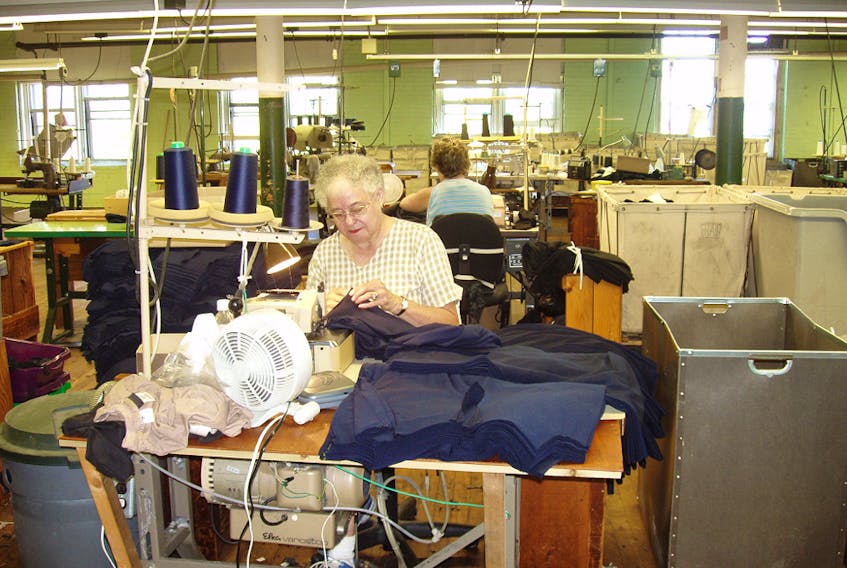WINDSOR, N.S. — Windsor’s iconic Nova Scotia Textiles mill building still stands tall, though these days, it looks a little worse for wear.
Travelling along Highway 101, it’s hard to miss the plant that once employed hundreds of people in Hants County. Its shadow looms large in the distance as motorists approach the town, reminiscent of a bygone era of big buildings and big dreams.
Driving by now, the dilapidated building sits unoccupied — save for a few squatters and transients.
There are more windows smashed out than not; doors are boarded up yet remain partially pried open. Miscellaneous construction material is strewn about the property; a roll of roofing paper sits discarded among the weeds.
It’s a far cry from the days the mill was a hub of activity.
But, Ed Macdonald, the last president of Nova Scotia Textiles Limited, and Windsor Mayor Anna Allen remain optimistic new life can once again flow through the rooms of the historic landmark.
“It’s been hard to see it deteriorate the way it has. It’s a very well-built building,” said Allen, who was on council when the mill shut down in 2005.
She said similar buildings around the world have been repurposed into condos, mixed residential and retail units, and businesses.
“Boston had a huge reinvention of those buildings along their waterfront,” she said. “You always hope that that’s what’s going to happen to this one, that it’s going to be revitalized to have a very good function in the community.”


WHERE IT ALL BEGAN
In the 1880s, prominent Windsor merchants and entrepreneurs saw an opportunity to maximize efficiencies. Ships were sailing out of the local ports, largely carrying agricultural products destined for the United States and England. To make the return trip profitable, they required freight that they could use.
“The building that is down off the highway there was originally built by local Windsor people in the 1880s. That was the era that the shipbuilding families were doing very well — people like the Churchills, the Dimocks,” said Macdonald, who has a wealth of historical knowledge on the area.
“In those days, the textile industry had started to migrate from New England down to the southeast to a degree. Textiles were considered a good secondary industry for job creation.”
The Windsor Cotton Company was incorporated in 1881. The initial directors of the company were Thomas Aylward, Mark Curry, William Curry, Edward Dimock, William Dimock, Godfrey Payzant, Bennett Smith, and John Sterling — all names that are still synonymous with the Windsor and Valley region today.

Three parcels of land — from Bennett Smith, Ellen O’Shaughnessy and Edward Elms — were acquired and construction began on the plant. The business was up and running in 1884.
“They saw an opportunity to improve their shipping efficiency and create what was then thought as good secondary jobs for the area. That took quite an entrepreneurial culture in the community to do that,” said Macdonald.
The mill was designed to make cotton sheeting and cotton products. It was purchased by Dominion Cotton by 1900 and continued to operate until that company consolidated a number of operating mills. It was sitting vacant by 1910.
Macdonald said much of Windsor’s history is tied to fire — the Great Windsor Fire of 1897 destroyed the majority of the town’s downtown but spared the textile mill — and such was the case with the next incarnation of the plant.
Nova Scotia Underwear, a company formed in Pictou County and originally called Eureka Woollen Mills in 1881, was focused on making knit underwear. Its main plant in Eureka was destroyed by fire in 1915. Windsor’s town council began courting the company and succeeded in attracting them. The company began operating in Windsor in 1916.
By 1922, Nova Scotia Textiles Limited became the successor to Nova Scotia Underwear and began to diversify its product range. That’s when Macdonald’s maternal grandfather, Edward Mortimer, got involved.
“That business primarily produced men’s winter weight underwear and then over the years, they got into t-shirts and briefs and sweat wear and casual wear,’ said Macdonald, noting as the decades progressed, so too did the company’s product line.

“As the industry developed, it got much more specialized. You couldn’t be producing mass market items in the Canadian market given the cost structure overseas,” said Macdonald.
Macdonald’s father, James Dunbar Macdonald — J.D. Macdonald — joined the company following the war and when Mortimer died in 1956, he took the reins. It was then passed down to Macdonald in 1990 after he worked there for 10 years.
By the end of the 1900s, Nova Scotia Textiles Ltd. had a number of brands — like the popular Windsor Wear and Gym-Master — plus private labels with Roots Canada and Eaton’s. They had branched out into providing flame-resistant wear and employed upwards of 200 people.
“It was a significant centre of jobs,” said Macdonald.
“When we wound up operations in 2005, we were paying an average labour rate of about $18 an hour plus fringe benefits, which would be about 30 per cent in things like pension insurance and so forth,” he added.
“They were good jobs, as they were at CKF or at Fundy Gypsum. They were not low-wage jobs in the area.”


TROUBLED INDUSTRY
A number of unforeseeable issues arose in the 90s and early 2000s which eventually led to the demise of the Nova Scotia Textiles Limited location in Windsor.
“Roots decided the ‘Made in Canada’ component wasn’t as significant to them at that point and they became more of a world-scale brand,” recalled Macdonald.
In 2003, the war in Iraq broke out and that led to issues with getting a steady supply of Nomex, a flame-resistant fibre than can be made into flame-resistant products. Clothing and equipment incorporating Nomex and Kevlar were both in high demand by the United States’ military.
Macdonald said even the tanks were being coated in an effort to make them more resistant to improvised explosive devices.
“DuPont is the principal supplier of that product and they’re required to supply the U.S. military before domestic markets,” explained Macdonald, noting the textile plant had been working with an Ohio-based firm on firefighting gear when the war began.
“Essentially, the restriction of supply that was necessary to supply the military meant that they couldn’t get enough product and they couldn’t be having a contractor to work here with laying their people off at their own plant in Ohio,” he said.
By 2005, an agreement was reached with Stanfield’s. The Windsor mill was shuttered, with brands and certain products heading to the Truro-based operation. Macdonald and one other employee stayed on with Stanfield’s; Macdonald retired two years ago.
“I think we had a very good team of people that were very flexible and very oriented to producing quality products,” said Macdonald, reflecting on the employees at Nova Scotia Textiles.

BRANDS LIVE ON
John Stanfield, chief executive officer of Stanfield’s, said the acquisition of the Nova Scotia Textiles Ltd. product line was advantageous for the company as they were looking to expand into providing industrial safety clothing.
“Obviously it was a positive thing. It got us into a market that we desired to have a better position in,” he said in a phone interview.
“I guess it gave us some equipment to improve our fleece and make our Stanfield’s brand a little better from a product perspective so… I think overall it was positive,” he added.
And it allowed a rich textile legacy to live on.
“The Macdonald family ran that for three generations and we’re five generations of operating in Nova Scotia,” said Stanfield.
“The synergies of the acquisition of the business not only made sense from the fact that they had a business that we desired to be in, but I guess from a legacy perspective, they wanted to see their brands continue on, continue to build, and that’s what we did,” said Stanfield.
Stanfield’s has been in business since 1856 (Charles Stanfield and his brother-in-law, Samuel E. Dawson, founded the Tryon Woolen Mills in Prince Edward Island) and has been located in Truro since the 1870s.
Stanfield said while they own the trademark to the Windsor Wear brand, it’s not used in the Stanfield’s line anymore.
“Gym-Master is still used sparingly in the markets that it existed. One of those markets was the Japanese market,” said Stanfield.
“Largely speaking, we’ve converted most of the products to the Stanfield’s brand,” he added.
Stanfield said they’ve benefited from the fleece equipment and technology that was developed at the Windsor plant, and “have been able to grow the fleece (side of the business) pretty significantly over the years.”
Stanfield’s only purchased the underlying business in 2005, not the property.
“We didn’t buy the building, so the building became a little bit of an albatross for everybody in the Windsor area,” said Stanfield.


PENDING REDEVELOPMENT
What will happen to the iconic plant has been a question posed since the site ceased operations nearly 15 years ago.
The property has changed hands a few times. There was a failed condominium-retail plan, billed as Mill Island Inc., shortly after the plant closed. Mill Island Limited was created in 2006 by Windsor businessman Terry Hines and Halifax brewer Kevin Keefe. The pair had a vision to transform the 76,000 square foot building into a bustling mixed retail-residential unit that would house everything from a microbrewery and art gallery to a bookstore and Swiss bakery. More than a dozen third floor condos were planned.

Renovations began in earnest later that year, with the building being gutted and new windows — nearly 200 of them — replaced and doors installed. But financial troubles soon plagued the redevelopment, and the global recession of 2008-09 dealt the fatal blow.
The building and land were listed at $3.1 million in 2010, but by 2015, that listing was closer to $1 million.
In 2017, the property was listed for sale for less than $1 million by Cushman Wakefield Atlantic, a commercial real estate company. It was owned by Moscowitz Capital, a company based in Ontario.
Navid Saberi, a Halifax developer who owns United Gulf Developments, is currently in possession of the building. It is unclear what his plans are at this point. Saberi could not be reached for comment as of press time.
Allen said area politicians have had discussions with Saberi on what they would like to see developed at the site.
“The owner now was looking at some ideas of what he could do with it. I don’t know where he’s at. We try to follow up with him as often as we can. We have really high hopes that he will actually do something,” said Allen.
With the pending merger of Windsor and West Hants municipalities, Allen said revitalizing the location could serve as a new beginning for the regionalized government.

“I know our two municipal units, when we amalgamate next March, we don’t have a home to go to just yet. So, there’s an opportunity to rent a whole floor, probably, to accommodate our needs,” she said. “We are looking for a home and there’s nothing big enough, at this point, except that building.”
Allen said she’s unsure if the developer is interested in offering office space plus residential units, but she said it’s an option the town would be interested in exploring with Saberi.
Macdonald said a developer with the right skillset, someone with experience with renovating older buildings and appreciation of history, could transform the old mill into a profitable venture.
“I think the building could be a good catalyst for the redevelopment of Windsor. There has been some interest in it, but I don’t know if there’s anything concrete planned at present,” he said.
“It would lend itself to something like an incubator mall where you could set up a number of small businesses with common facilities and combine that with some residential,” Macdonald said, alluding to the original plan for Mill Island.
“I think it could probably still be done but it needs a fair amount of capital in that you would not only want to purchase the building and the land immediately around it, but you’d really need to purchase the additional lots on Nesbitt Street,” Macdonald said.
“There are some owner-occupied homes there that are in good condition but there are others that really should be replaced with townhouses and that type of thing. On the hill, you’d have the opportunity to develop some very nice home sights overlooking the confluence of the Avon, St. Croix River estuaries.”
The plant is located on Nesbitt Street, near the off ramp for Exit 6 to downtown Windsor. It’s about a 40-minute drive to Halifax.
“With the right mix, it could be quite an attractive suburban location for people who have lived in a larger centre, like Montreal, Toronto or Chicago, and appreciate the convenience of the lifestyle we have here,” said Macdonald.
“It would have been a building that was redeveloped a long time ago if it was sitting in the middle of a major urban centre.”


Timeline
1881
Windsor Cotton Company is incorporated by Windsor business leaders; three parcels of land on ‘the island’ are purchased
1884
Construction is finished on the plant to house the Windsor Cotton Company
By 1900
Windsor Cotton Company is acquired by Dominion Cotton Company (headquartered in Montreal)
1908-10
The Dominion Cotton Company’s location in Windsor closes due to the company’s consolidation of operating mills
1915
Fire destroys the Nova Scotia Underwear Company’s plant in Eureka, Pictou County, and Windsor town council begins courting the business to move to town
1916
Nova Scotia Underwear Company relocates to Windsor’s vacant mill and resumes production
1920s
Nova Scotia Textiles Limited is established as the successor to Nova Scotia Underwear Company; product diversification begins; Edward Mortimer takes the helm
1930s
Windsor Wear brand is developed; Gym-Master brand plus several private label products follow over the decades
1950s
A satellite sewing facility opens in Bridgetown in order to access additional labourers
1956
Edward Mortimer dies; James Dunbar Macdonald — J.D. Macdonald — becomes president
1978
Production on Roots Sweatwear begins
1980
Ed Macdonald begins working at Nova Scotia Textiles Ltd.
1990
Ed Macdonald becomes president of Nova Scotia Textiles Limited; contract with Roots Canada ends
2003
Iraq War begins, resulting in a shortage of Nomex, a fire-retardant material that Nova Scotia Textiles Ltd. was using to produce specialty products
2005
Stanfield’s acquires product lines and machinery, but not the property; remaining workers laid off with two heading to Stanfield’s Truro operation
2006
The planned redevelopment of the site by Mill Island Limited gets underway
2008-09
Economic recession hits; plans for a mixed condominium and retail space known as Mill Island Ltd. fails
2010
Property is listed for $3.1 million
2017
Property is listed for sale just shy of $1 million by Cushman Wakefield Atlantic, a commercial real estate company; property is owned by Moscowitz Capital, a company based in Ontario
2017
Hants County artist Terra Spencer pens a song, Cotton Mill, about the site, with a video uploaded to YouTube in December (see video below): https://youtu.be/VfGDWyB65qI
2018
Halifax developer Navid Saberi, who owns United Gulf Developments, acquires the property










